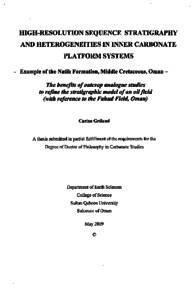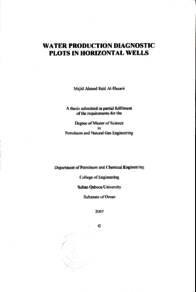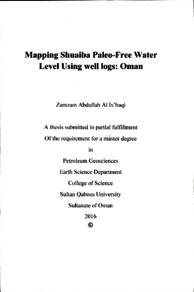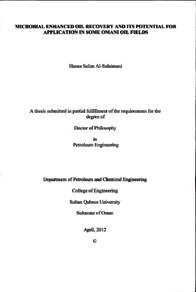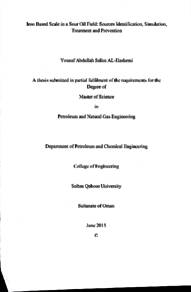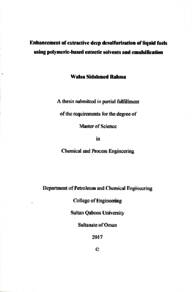Document
Deep desulfurization of liquid fuels with green solvents : an approach with deep eutectic solvents
Publisher
Sultan Qaboos University
Gregorian
2015
Language
English
Subject
English abstract
The ever changing environmental sulfur regulations have made researchers develop alternative desulfurization techniques beyond the conventional and industrially practiced hydrodesulfurization. Among these techniques, extractive desulfurization (EDS) has shown promising potentials towards desulfurization of liquid fuels to below environmental set limits. The proper choice of an efficient solvent in EDS could make or mar completely the overall process. Due to the challenges posed by the conventional solvents in EDS, green solvents have garnered a substantive attention.
In this work, a new idea of using Deep Eutectic Solvents (DESs) for the deep extractive desulfurization of liquid fuels has been systematically carried out. Due to its novelty, the work started by carefully screening and synthesizing various ratios of different DES systems that cut across the conventional DES types of Type I, Type II, Type III and Type IV. The work went further to evaluate the synthesized DESs based on their affinity for sulfur containing compounds of dibenzothiophene (DBT) and thiophene, which are commonly found in liquid fuels, via solubility experiments. Among the DESs with reasonable affinity for sulfur compounds, Type I of FeCl3 and SnCl2 and Type II of SnCl2.2H20 have shown remarkable solubility for the studied sulfur compounds. Others include the Type III DESs of Polyethylene glycol (PEG200), Imidazole and Sulfolane. These DESs were further employed for the extractive desulfurization of liquid fuels ranging from simulated fuel to commercial grade diesel oil. Simple batch mixing-settling extraction process was emulated. The effect of extraction variables of time, temperature and solvent mass fraction (mass fraction of solvent in the solvent and fuel mixture), all on the sulfur extraction efficiency of the DESs were collectively monitored statistically using the experimental design technique of Response Surface Methodology (RSM). The technique has not only allowed for the modeling of the extraction process in terms of these variables but also helped in the optimization of the process. In addition, the effects of initial sulfur concentration in fuel and solvent extraction capacity, all on the sulfur removal efficiency of the solvents were investigated.
At various stages of the work, High Performance Liquid Chromatography (HPLC) and Energy Dispersive X-ray Fluorescence (EDXRF) were employed for the analytical monitoring, evaluation and quantification of sulfur compounds in DESs during solubility experiments and in the liquid fuels before and after extraction experiments. Similarly, Electrospray Ionization - Mass Spectroscopy (ESI-MS), Nuclear Magnetic Resonance (NMR) and Fourier Transform Infrared Spectroscopy (FTIR) were employed for characterization of the DESs' before/after extraction and solvents' regeneration accordingly.
Among the DESs employed for the EDS of the simulated fuel, sulfolane containing DES showed the highest DBT and thiophene removal efficiencies of 81.32% and 59.46%, respectively, at optimum extraction conditions of time, temperature and solvent mass fraction. This was followed by the DES containing imidazole with 76.19% and 55.53% also for DBT and thiophene, respectively. Others are the anhydrous stannous chloride containing DES with 72.97% and 49.95%, anhydrous ferric chloride DES with 71.67% and 48.52%, respectively, for DBT and thiophene.
The deep desulfurization of the fuels to below the environmental sulfur regulation in Oman was successfully accomplished in five (5) extraction stages, conducted in such a way that fresh solvent was added to the raffinate of the previous stage in the required solvent mass fraction. The high amount of solvent required to achieve the deep desulfurization of the fuels necessitated the regeneration of the solvents for repetitive usage and the results showed that the water soluble DESs could be regenerated up to four (4) times without any significant loss in their sulfur extraction abilities. The achieved solvent recovery at the end of each regeneration cycle was also remarkable.
Apart from being nontoxic and cheap in terms of constituent materials, and easy to synthesize, the performances of these DESs stand promising when compared with the performance of their ionic liquid counterparts employed for the same purpose as reported in the literature. This is in addition to the fact that a simulated fuel and ultimately a commercial grade diesel fuel were used in this work while most of the works carried out with ionic liquids were conducted with a model fuel whose properties may not be adjudged to be similar to real fuel.
Arabic abstract
التغيرات المستمرة في القوانين البيئية المتعلقة بنسب الكبريت جعلت الباحثين يقومون بتطوير تقنيات بديلة لإزالة الكبريت بعيدا عن الطرق التقليدية المتبعة صناعيا باستخدام الهيدروجين. من بين هذه التقنيات إزالة الكبريت بالاستخلاص و التي قد أظهرت نتائج واعدة في ازالة الكبريت من الوقود السائل المستويات أقل من المعايير البيئية المتفق عليها .
الحاجة الى مذيب فعال في تقنية إزالة الكبريت لا يمكن تجاهلها بسبب التحديات التي تشكلها المذيبات التقليدية ولذلك فقد نالت المذيبات الخضراء اهتماما كبيرا. في هذا البحث تم تطبيق فكرة جديدة بشكل منهجي تكمن في استخدام مذيبات يوتيكتيكية في عملية إزالة الكبريت بالاستخلاص من الوقود السائل. و نظرا لحداثة الفكرة ، ابتدأ العمل بمسح دقيق وتوليف نسب متعددة لأنظمة مذيبات يوتيكتيكية مختلفة التركيب.
تواصل العمل لتقييم المذيبات المولفة طبقا لقدرتها في جذب المركبات الكبريتية كثاني بنزوثيوفين والثيوفين الذين يتواجدان بشكل شائع في الوقود السائل باستخدام تجارب الذوبانية . من بين المذيبات اليوتيكتيكية التي تتميز بقدرة جذب معقولة لمركبات الكبريت , النوع الأول SnCl كلوريد القصدير و FeCl3 كلوريد الحديد و كذلك النوع الثاني كلوريد القصدير ثنائي المائية SnCl2. 2H20 .
وقد أظهرت هذه المذيبات ذوبانية ملحوظة لمركبات الكبريت المشمولة في الدراسة بالإضافة للنوع الثالث من المذيبات المشتملة على البولي ايثلين جليكول 200 و الإيميدازول و السلفولين . هذه المذيبات وظفت لإزالة الكبريت بالاستخلاص من الوقود السائل بنوعية الوقود المحاکی وصنف الديزل التجاري . وكذلك تمت محاكاة عملية الاستخلاص بالمزج البسيط الدفعي - المستقر.
تأثیر متغيرات الاستخلاص مثل الزمن، درجة الحرارة و الكسر الوزني للمذيب على فعالية استخلاص الكبريت تم رصدها جميعا بشكل احصائي عن طريق تقنية التصميم التجريبي لاستجابة السطح المنهجية (RSM).
التقنية لم تقتصر على تصميم عملية الاستخلاص من ناحية هذه المتغيرات بل ساعدت في إيجاد الظروف المثلى لتحسين العملية. تم دراسة تأثير تركيز الكبريت الابتدائي في الوقود وقدرة المذيب على الاستخلاص على فعالية المذيب في إزالة الكبريت .
خلال مراحل العمل المتعددة، تم استخدام جهاز التحليل الكروموتوغرافي السائل عالي الأداء و جهاز فلورة الأشعة السينية في الرصد التحليلي ،وفي تقييم وتحديد كمية مركبات الكبريت في المذيبات خلال تجارب الذوبانية ، وفي الوقود السائل قبل وبعد تجارب الاستخلاص. وبالمثل جهاز مطياف الكتلة - التأين بالرذاذ الالكتروني ، جهاز الرنين المغناطيسي النووي وجهاز مطيافية الأشعة تحت الحمراء بتحويل فورير تم استخدامها في تصنيف المذيبات قبل وبعد الاستخلاص وفي تجديد(اعادة تدوير) المذيبات .
من بين المذيبات المستخدمة في عملية ازالة الكبريت بالاستخلاص للوقود المحاکی ، المذيبات المحتوية على السولفولين قد اظهرت أعلى فعالية في ازالة مركب ثنائي بنزو ثيوفين و الثيوفين بنسب قدرها 81.32 % و 59 . 46 % تباعا في امثل الظروف للاستخلاص كالزمن ، درجة الحرارة و الكسر الوزني للمذيب . متبوعة بالمذيبات المحتوية على الايميدازول بنسب قدرها 76. 19 % ة 55 . 53 % لثنائي بنزو ثيوفين والثيوفين تباعا . المذيبات الأخرى المحتوية على كلوريد القصدير اللامائي بنسب 72. 97 % و 49 .95 % و كلوريد الحديد اللامائي بنسبة 71 . 67 % لثنائي بنزو ثيوفين و 48. 52 للثيوفين .
عملية إزالة الكبريت من الوقود لمستويات أقل من المعايير البيئية للكبريت في عمان قد تم تحقيقها في خمس (5) مراحل للاستخلاص ،نفذت بحيث يتم اضافة المذيب النقي (غير المستخدم الى المستخلص الناتج من المرحلة السابقة بالنسب الوزنية.
كان من المطلوب واللازم تجديد المذيب من أجل إعادة استخدامه نسبة لكبر كمية المذيب المستخدمة لتحقيق ازالة فعالة للكبريت من الوقود ، وقد أثبتت النتائج أن المذيبات سهلة الانصهار القابلة للذوبان في الماء يمكن تجديدها إلى حد يصل إلى أربع (4) مرات بدون أي تدني في قدرة وفعالية استخلاص الكبريت. المذيب المتحصل عليه من عملية التجديد (التدوير) في نهاية كل دورة تجديد كان أيضا استثنائيا وجدير بالملاحظة .
إضافة إلى عدم سمية و رخص المواد الأساسية المكونة للمذيب وسهولة توليفها ، يظل أداء هذه المذيبات واعدا مقارنة باداء نظائرها من المذيبات الأيونية المستخدمة لنفس الغرض كما ورد في الدراسات. هذا بالإضافة إلى حقيقة أن الوقود المحاکی وصنف الديزل التجاري تم استخدامهما في هذا العمل، بينما معظم العمل باستخدام المذيبات الأيونية تم إنجازه باستخدام وقود منمذج مواصفاته لا تماثل مواصفات الوقود الحقيقي .
الحاجة الى مذيب فعال في تقنية إزالة الكبريت لا يمكن تجاهلها بسبب التحديات التي تشكلها المذيبات التقليدية ولذلك فقد نالت المذيبات الخضراء اهتماما كبيرا. في هذا البحث تم تطبيق فكرة جديدة بشكل منهجي تكمن في استخدام مذيبات يوتيكتيكية في عملية إزالة الكبريت بالاستخلاص من الوقود السائل. و نظرا لحداثة الفكرة ، ابتدأ العمل بمسح دقيق وتوليف نسب متعددة لأنظمة مذيبات يوتيكتيكية مختلفة التركيب.
تواصل العمل لتقييم المذيبات المولفة طبقا لقدرتها في جذب المركبات الكبريتية كثاني بنزوثيوفين والثيوفين الذين يتواجدان بشكل شائع في الوقود السائل باستخدام تجارب الذوبانية . من بين المذيبات اليوتيكتيكية التي تتميز بقدرة جذب معقولة لمركبات الكبريت , النوع الأول SnCl كلوريد القصدير و FeCl3 كلوريد الحديد و كذلك النوع الثاني كلوريد القصدير ثنائي المائية SnCl2. 2H20 .
وقد أظهرت هذه المذيبات ذوبانية ملحوظة لمركبات الكبريت المشمولة في الدراسة بالإضافة للنوع الثالث من المذيبات المشتملة على البولي ايثلين جليكول 200 و الإيميدازول و السلفولين . هذه المذيبات وظفت لإزالة الكبريت بالاستخلاص من الوقود السائل بنوعية الوقود المحاکی وصنف الديزل التجاري . وكذلك تمت محاكاة عملية الاستخلاص بالمزج البسيط الدفعي - المستقر.
تأثیر متغيرات الاستخلاص مثل الزمن، درجة الحرارة و الكسر الوزني للمذيب على فعالية استخلاص الكبريت تم رصدها جميعا بشكل احصائي عن طريق تقنية التصميم التجريبي لاستجابة السطح المنهجية (RSM).
التقنية لم تقتصر على تصميم عملية الاستخلاص من ناحية هذه المتغيرات بل ساعدت في إيجاد الظروف المثلى لتحسين العملية. تم دراسة تأثير تركيز الكبريت الابتدائي في الوقود وقدرة المذيب على الاستخلاص على فعالية المذيب في إزالة الكبريت .
خلال مراحل العمل المتعددة، تم استخدام جهاز التحليل الكروموتوغرافي السائل عالي الأداء و جهاز فلورة الأشعة السينية في الرصد التحليلي ،وفي تقييم وتحديد كمية مركبات الكبريت في المذيبات خلال تجارب الذوبانية ، وفي الوقود السائل قبل وبعد تجارب الاستخلاص. وبالمثل جهاز مطياف الكتلة - التأين بالرذاذ الالكتروني ، جهاز الرنين المغناطيسي النووي وجهاز مطيافية الأشعة تحت الحمراء بتحويل فورير تم استخدامها في تصنيف المذيبات قبل وبعد الاستخلاص وفي تجديد(اعادة تدوير) المذيبات .
من بين المذيبات المستخدمة في عملية ازالة الكبريت بالاستخلاص للوقود المحاکی ، المذيبات المحتوية على السولفولين قد اظهرت أعلى فعالية في ازالة مركب ثنائي بنزو ثيوفين و الثيوفين بنسب قدرها 81.32 % و 59 . 46 % تباعا في امثل الظروف للاستخلاص كالزمن ، درجة الحرارة و الكسر الوزني للمذيب . متبوعة بالمذيبات المحتوية على الايميدازول بنسب قدرها 76. 19 % ة 55 . 53 % لثنائي بنزو ثيوفين والثيوفين تباعا . المذيبات الأخرى المحتوية على كلوريد القصدير اللامائي بنسب 72. 97 % و 49 .95 % و كلوريد الحديد اللامائي بنسبة 71 . 67 % لثنائي بنزو ثيوفين و 48. 52 للثيوفين .
عملية إزالة الكبريت من الوقود لمستويات أقل من المعايير البيئية للكبريت في عمان قد تم تحقيقها في خمس (5) مراحل للاستخلاص ،نفذت بحيث يتم اضافة المذيب النقي (غير المستخدم الى المستخلص الناتج من المرحلة السابقة بالنسب الوزنية.
كان من المطلوب واللازم تجديد المذيب من أجل إعادة استخدامه نسبة لكبر كمية المذيب المستخدمة لتحقيق ازالة فعالة للكبريت من الوقود ، وقد أثبتت النتائج أن المذيبات سهلة الانصهار القابلة للذوبان في الماء يمكن تجديدها إلى حد يصل إلى أربع (4) مرات بدون أي تدني في قدرة وفعالية استخلاص الكبريت. المذيب المتحصل عليه من عملية التجديد (التدوير) في نهاية كل دورة تجديد كان أيضا استثنائيا وجدير بالملاحظة .
إضافة إلى عدم سمية و رخص المواد الأساسية المكونة للمذيب وسهولة توليفها ، يظل أداء هذه المذيبات واعدا مقارنة باداء نظائرها من المذيبات الأيونية المستخدمة لنفس الغرض كما ورد في الدراسات. هذا بالإضافة إلى حقيقة أن الوقود المحاکی وصنف الديزل التجاري تم استخدامهما في هذا العمل، بينما معظم العمل باستخدام المذيبات الأيونية تم إنجازه باستخدام وقود منمذج مواصفاته لا تماثل مواصفات الوقود الحقيقي .
Member of
Resource URL
Same Subject
